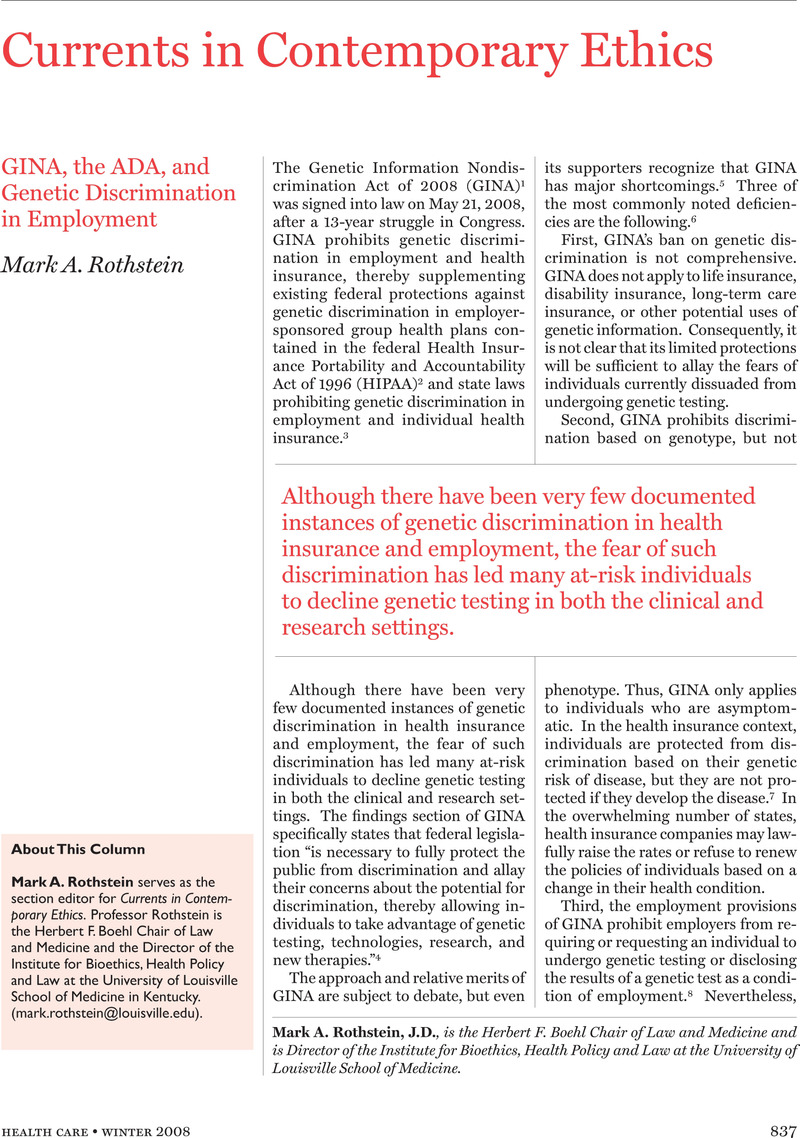Crossref Citations
This article has been cited by the following publications. This list is generated based on data provided by Crossref.
Rothstein, Mark A.
and
Harrell, Heather L.
2009.
Health Risk Reduction Programs in Employer-Sponsored Health Plans: Part II—Law and Ethics.
Journal of Occupational & Environmental Medicine,
Vol. 51,
Issue. 8,
p.
951.
Tong, Weida
and
Mendrick, Donna L.
2010.
Biomarkers.
p.
7.
Novelli, Giuseppe
2010.
Role of genomics in cardiovascular medicine.
World Journal of Cardiology,
Vol. 2,
Issue. 12,
p.
428.
Roberts, Laura Weiss
Barry, Liliana Kalogjera
and
Warner, Teddy D.
2011.
Potential Workplace Discrimination Based on Genetic Predisposition: Views of Workers.
AJOB Primary Research,
Vol. 2,
Issue. 3,
p.
1.
Jordan, Lanetta B.
Smith-Whitley, Kim
Treadwell, Marsha J.
Telfair, Joseph
Grant, Althea M.
and
Ohene-Frempong, Kwaku
2011.
Screening U.S. College Athletes for Their Sickle Cell Disease Carrier Status.
American Journal of Preventive Medicine,
Vol. 41,
Issue. 6,
p.
S406.
Kang, Peter B.
2011.
Presymptomatic and Early Symptomatic Genetic Testing.
CONTINUUM: Lifelong Learning in Neurology,
Vol. 17,
Issue. ,
p.
343.
Soden, Sarah E
Farrow, Emily G
Saunders, Carol J
and
Lantos, John D
2012.
Genomic medicine: evolving science, evolving ethics.
Personalized Medicine,
Vol. 9,
Issue. 5,
p.
523.
Rothstein, Mark A.
2012.
Currents in Contemporary Bioethics.
Journal of Law, Medicine & Ethics,
Vol. 40,
Issue. 2,
p.
394.
Prince, Anya E. R.
and
Berkman, Benjamin E.
2012.
When Does an Illness Begin: Genetic Discrimination and Disease Manifestation.
Journal of Law, Medicine & Ethics,
Vol. 40,
Issue. 3,
p.
655.
Laedtke, Amanda L.
O'Neill, Suzanne M.
Rubinstein, Wendy S.
and
Vogel, Kristen J.
2012.
Family Physicians’ Awareness and Knowledge of the Genetic Information Non‐Discrimination Act (GINA).
Journal of Genetic Counseling,
Vol. 21,
Issue. 2,
p.
345.
Steck, Mary Beth
2012.
Concept Analysis: Awareness of Discrimination Based on Genetic Information.
Nursing Forum,
Vol. 47,
Issue. 2,
p.
100.
DUAN, Guoli
ZHAI, Xiao
HE, Qianyun
LI, Junqiang
LIU, Jie
and
ZHANG, Yan
2013.
Investigations and thoughts of the ethics in genetic discrimination.
Journal of Medical Colleges of PLA,
Vol. 28,
Issue. 1,
p.
46.
McClellan, Kelly A
Avard, Denise
Simard, Jacques
and
Knoppers, Bartha M
2013.
Personalized medicine and access to health care: potential for inequitable access?.
European Journal of Human Genetics,
Vol. 21,
Issue. 2,
p.
143.
Mautz, Karla A.
2013.
Do You Know GINA? If Not, You Should.
SSRN Electronic Journal,
Kang, Peter B.
2013.
Ethical and Legal Issues in Neurology.
Vol. 118,
Issue. ,
p.
265.
Rothstein, Mark A.
2013.
HIPAA Privacy Rule 2.0.
Journal of Law, Medicine & Ethics,
Vol. 41,
Issue. 2,
p.
525.
Arias, Jalayne J.
and
Karlawish, Jason
2014.
Confidentiality in preclinical Alzheimer disease studies.
Neurology,
Vol. 82,
Issue. 8,
p.
725.
Prince, Anya E. R.
and
Roche, Myra I.
2014.
Genetic Information, Non‐Discrimination, and Privacy Protections in Genetic Counseling Practice.
Journal of Genetic Counseling,
Vol. 23,
Issue. 6,
p.
891.
Munshi, Anjana
and
Sharma, Vandana
2014.
Cancer Biomarkers.
p.
3.
Wolf, Susan M.
Branum, Rebecca
Koenig, Barbara A.
Petersen, Gloria M.
Berry, Susan A.
Beskow, Laura M.
Daly, Mary B.
Fernandez, Conrad V.
Green, Robert C.
LeRoy, Bonnie S.
Lindor, Noralane M.
O'Rourke, P. Pearl
Breitkopf, Carmen Radecki
Rothstein, Mark A.
Van Ness, Brian
and
Wilfond, Benjamin S.
2015.
Returning a Research Participant's Genomic Results to Relatives: Analysis and Recommendations.
Journal of Law, Medicine & Ethics,
Vol. 43,
Issue. 3,
p.
440.





